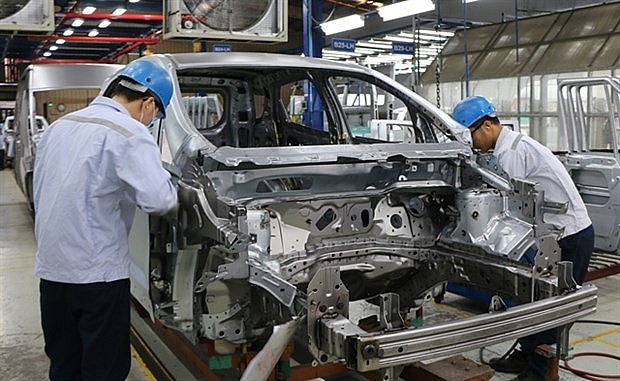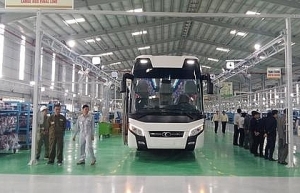Regulations on auto localisation ratio to be revoked
Hanoi - Regulations on the automobile localisation ratio will be abolished on October 10, 2022 after having been in force for almost 20 years.
 |
| Workers assemble cars at Ford Hai Duong. Regulations on the automobile localisation ratio will soon be revoked to be in line with the development and change of technological processes of automobile production and assembly. (Photo: VNA) |
The Ministry of Science and Technology in mid-August enacted Circular No 11/2022/TT-BKHCN to rescind the regulations on methods to calculate the automobile localisation ratio, including Decision No 28/2004, Decision No 05/ 2005 and Circular 05/2012. The new circular will take effect from October 1 this year.
Under current regulations, Vietnam calculates the automobile localisation ratio by clusters of components produced in the country. Meanwhile, other countries calculate this as a percentage of domestic production value.
This makes it difficult for businesses to enjoy the preferential import tax rate of 0% if the automobile localisation ratio within the bloc, as with ASEAN, is 40 percent.
Regarding the discrete level of imported auto parts, components must come in clusters, accompanied by many different details.
Vietnam's automobile industry remains a fledgling one after more than 30 years since the country opened its door to foreign investment.
The current average localisation ratio of passenger cars with up to nine seats is as low as 7-10percent, according to data released by Deputy Minister of Industry and Trade Do thang Hai last August. The Government target is 30-40percent by 2020, 40-45percent by 2025 and 50-55percent by 2030.
The Ministry of Industry and Trade (MoIT) reports that the current localisation ratio is now 40-50% for trucks, and 55% for buses. Therefore, the current regulations related to methods of determining the localisation rate were no longer relevant.
Automotive experts said the abolition of these regulations is in line with the development and change of technological processes of automobile production and assembly in the country and the world to ensure transparency. The abolition will also help meet international standards.
The removal of those regulations will also help improve the investment climate and allow domestic automobile manufacturers to maintain production in competition with completely-built-up (CBU) cars imported from ASEAN countries with a tax rate of 0% from 2018.
According to the MoIT, the localisation rate of passenger cars in Vietnam is still quite low due to the slow development of auto parts and accessories suppliers, in terms of both quantity and quality. Only a few domestic suppliers can get involved in the supply chains of automobile manufacturers in Vietnam.
According to the MoIT, the average output growth of the auto industry is much lower than that of the whole industry.
Domestic enterprises have been left behind in the race for high-quality auto parts and accessories due to their low speed of technological innovation. Many auto parts suppliers still have little capability and production technology to get involved in the value chains of the domestic automotive industry.
Over the past 10 years, Vietnam has signed a series of free trade agreements (FTAs), such as the ASEAN Trade in Goods Agreement, the Comprehensive and Progressive Agreement for Trans-Pacific Partnership, and the EU–Vietnam Free Trade Agreement.
These agreements require member states to commit to the removal of tariff barriers for imported cars and auto parts.
 | Local car maker increases localisation rate Local car maker Truong Hai Automobile company (Thaco) has increased the proportion of components it sources from local suppliers in order to reduce sale prices and improve competitiveness, as tariffs on cars have fallen to zero throughout the ASEAN region. |
| 30 per cent of localisation ratio yet to be "made in Vietnam" goods Simply having a localisation ratio of 30 per cent is not enough to qualify as a “Made in Vietnam” product to circulate on the home market, according to the latest draft circular by the Ministry of Industry and Trade, companies will need to do at least simple processing here as well. |
 | Localisation the key for offshore venture victories Investors are showing more ambition when it comes to high-quality offshore projects. Riccardo Felici, country manager for renewables consultants OWC Vietnam, told VIR’s Nguyen Thu about the challenges in the energy transition path and lessons for this country in particular. |
What the stars mean:
★ Poor ★ ★ Promising ★★★ Good ★★★★ Very good ★★★★★ Exceptional
Related Contents
Latest News
More News
- Businesses ramp up production as year-end orders surge (December 30, 2025 | 10:05)
- Vietjet chairwoman awarded Labour Hero title (December 29, 2025 | 13:06)
- How to unlock ESG value through green innovation (December 29, 2025 | 10:03)
- AI reshapes media and advertising industry (December 29, 2025 | 08:33)
- FPT and GELEX sign deal to develop blockchain tech for global markets (December 29, 2025 | 08:29)
- Vietnam’s GDP forecast to grow by 9 per cent in 2026 (December 29, 2025 | 08:29)
- Women entrepreneurs are key to Vietnam’s economic growth (December 29, 2025 | 08:00)
- Vietnam's top 500 value-creating enterprises announced (December 27, 2025 | 08:00)
- The PAN Group shaping a better future with ESG strategy (December 26, 2025 | 09:00)
- Masan Consumer officially lists on HSX, marking the next phase of value creation (December 25, 2025 | 13:20)

 Tag:
Tag:



















 Mobile Version
Mobile Version